Abstract
Fastidious viruses are generally detected in human body fluids by means of immunoassay or nucleic acid hybridization systems. These approaches can be difficult to apply to the detection of viruses which display variations in antigenic or genetic composition. Rotaviruses are examples of viruses which can display such variations. Recently identified antigenic variants, designated as non-group A rotaviruses, cannot be detected by immunoassays or nucleic acid hybridization assays which utilize reagents directed at group A rotavirus strains. The incomplete understanding of the extent of antigenic and genetic variation has inhibited the development of assay systems for all of the non-group A rotaviruses and has limited the study of their role in human disease. While rotaviruses display genetic variation, they all contain a genome which consists of double-stranded RNA. We utilized a monoclonal antibody to devise a sensitive assay for the measurement of double-stranded RNA and applied it to the detection of a wide range of rotaviruses. We found that the assay could detect double-stranded RNA from as few as 10 PFU of standard strains of group A rotaviruses. The assay system was also capable of detecting double-stranded RNA from several strains of group B rotaviruses isolated from calves, rats, and pigs at levels below those at which viral RNA could be visualized by means of polyacrylamide gel electrophoresis. When applied to the detection of double-stranded RNA in serial stools shed by rotavirus-infected children, the assay system was capable of detecting double-stranded RNA in samples in which antigen could not be detected by immunoassay. The specific nature of the double-stranded RNA detected by this assay system could be determined by the elution of the nucleic acids from the monoclonal antibody and the reaction of the RNA with specific nucleotide probes. The measurement of double-stranded RNA offers a potential method for the sensitive detection of a wide range of rotaviruses and other members of the family Reoviridae.
Full text
PDF
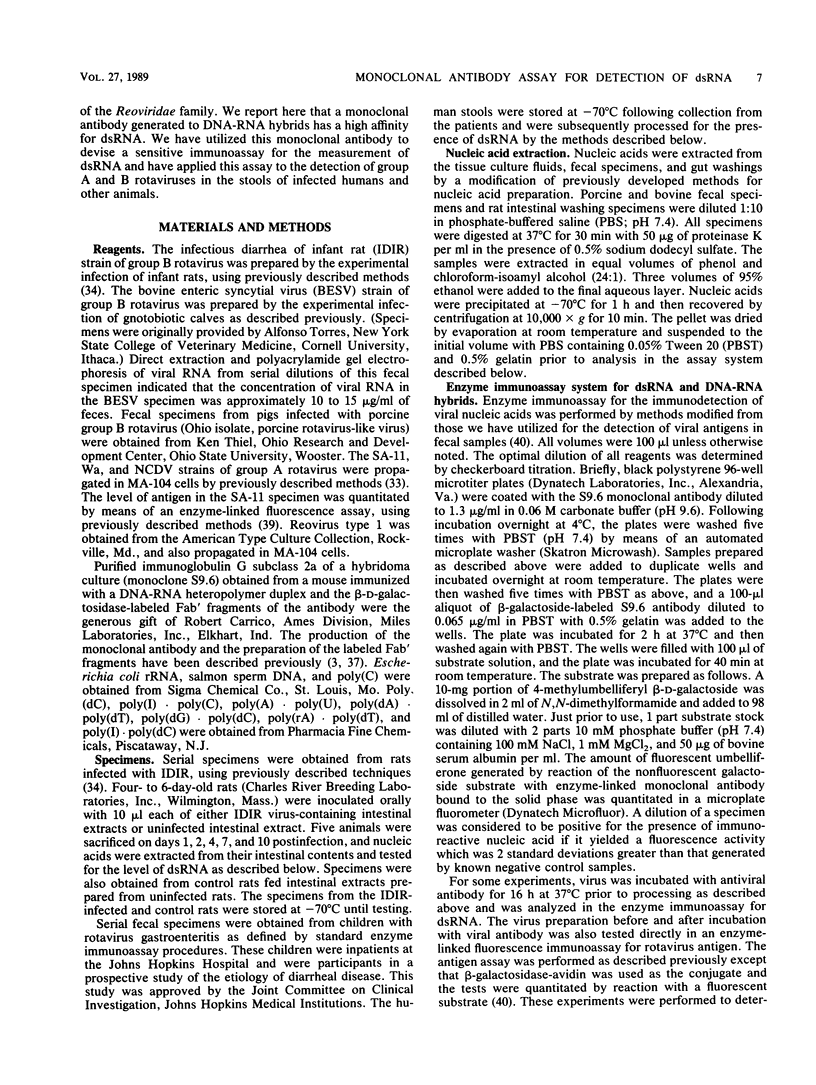
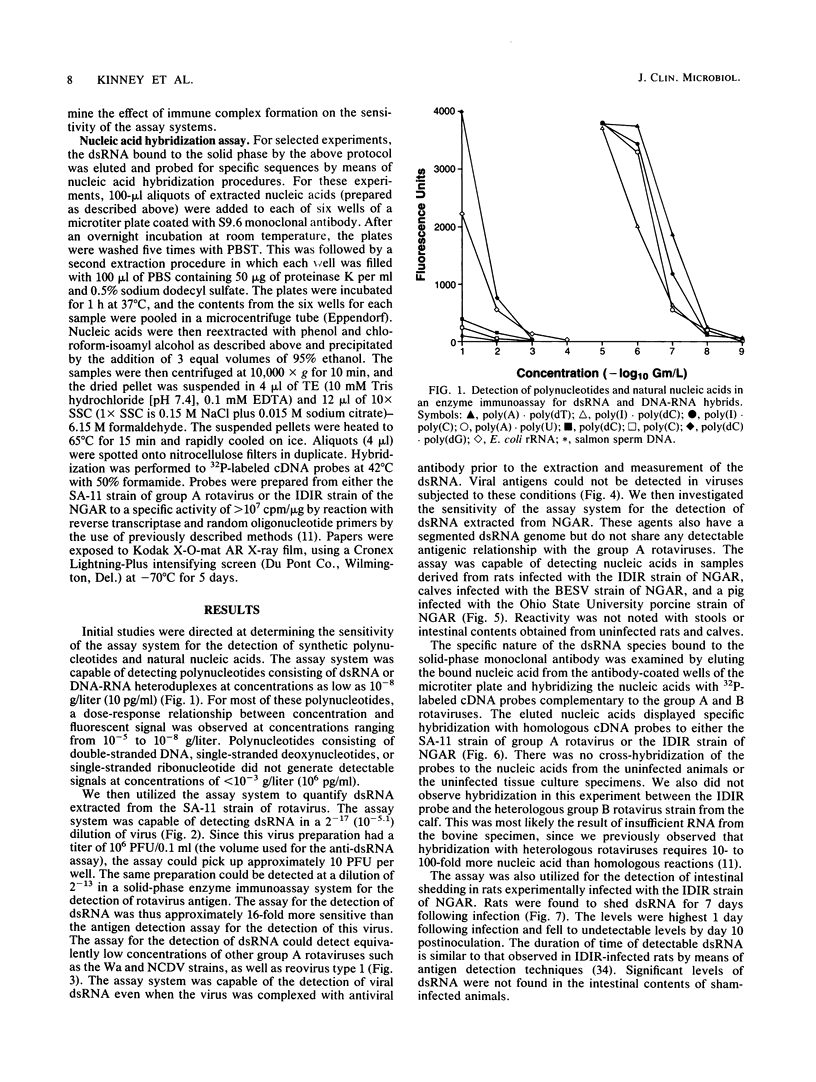
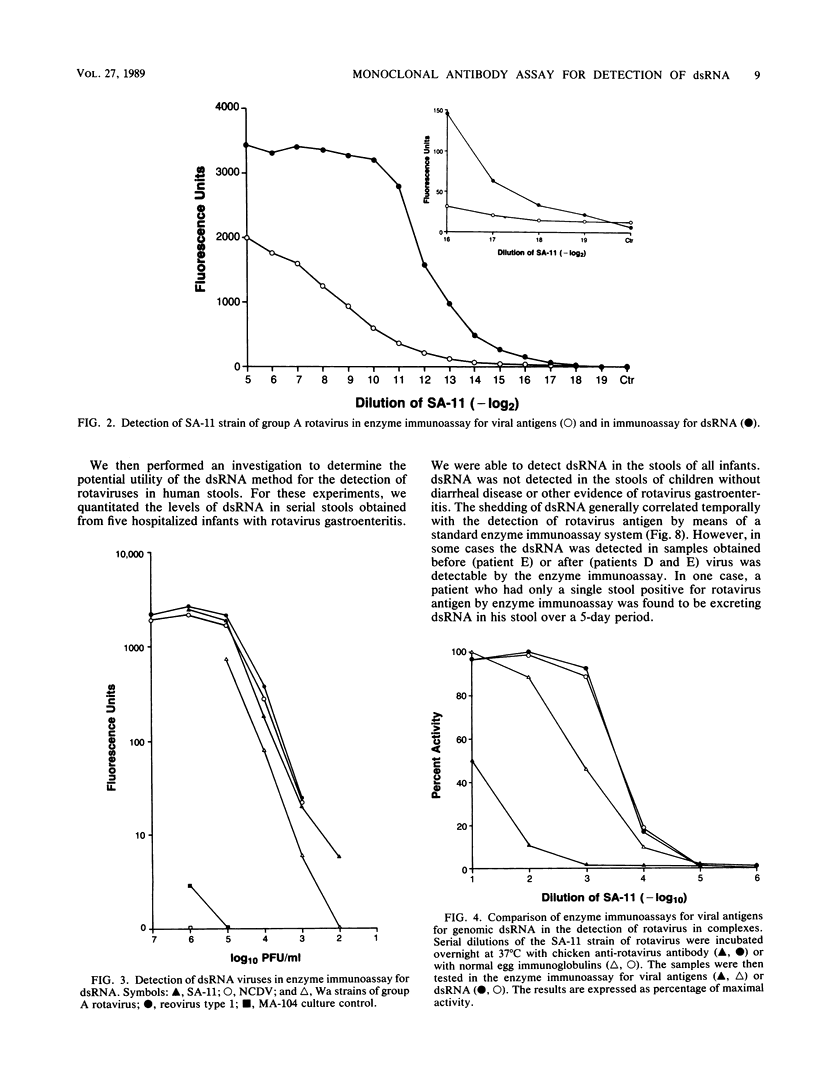
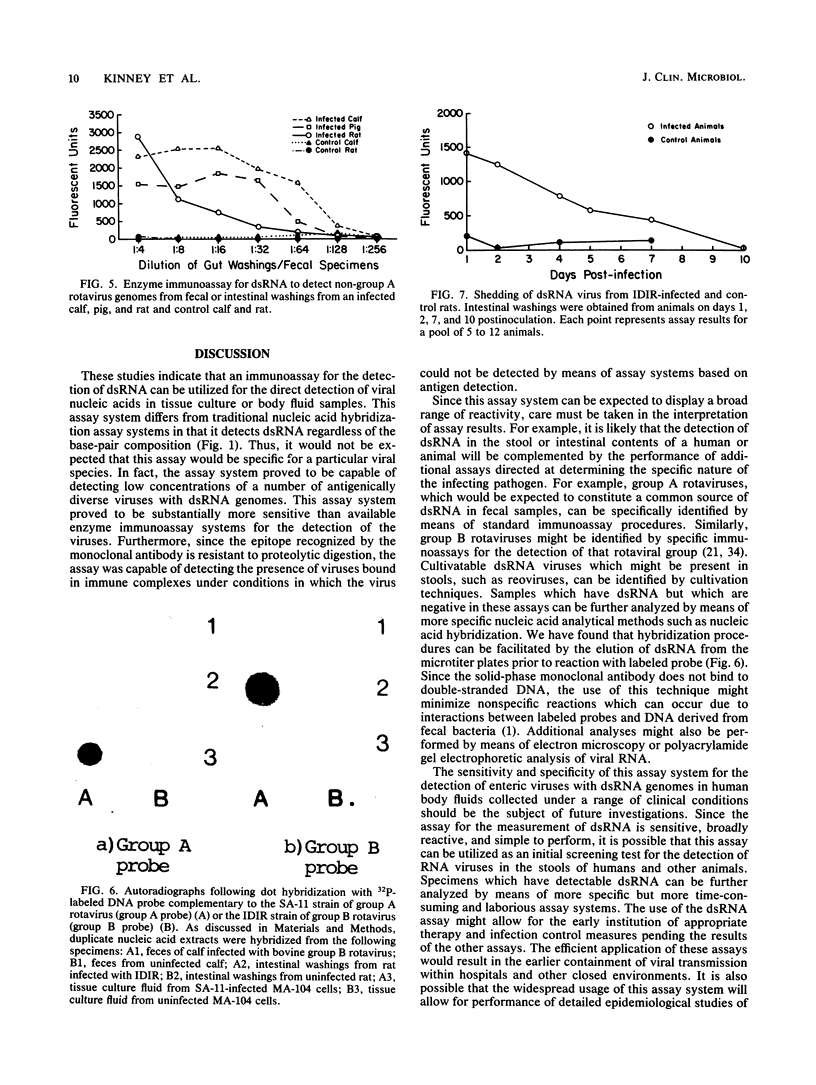
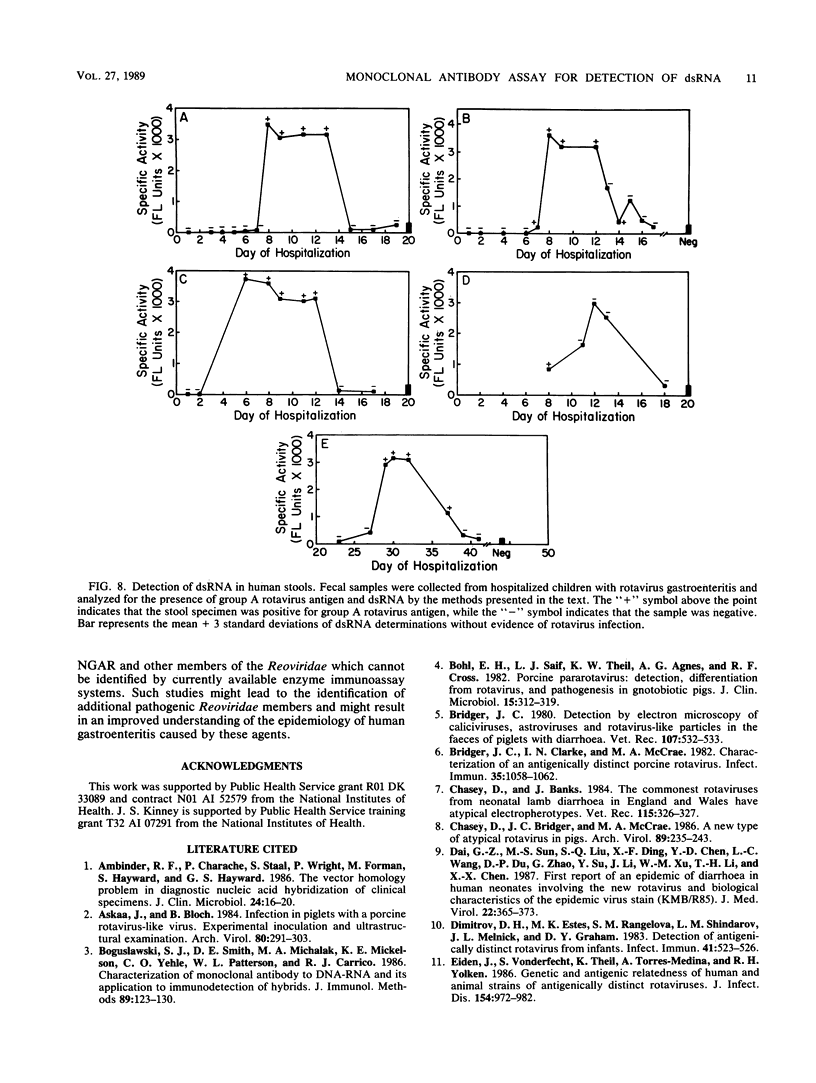
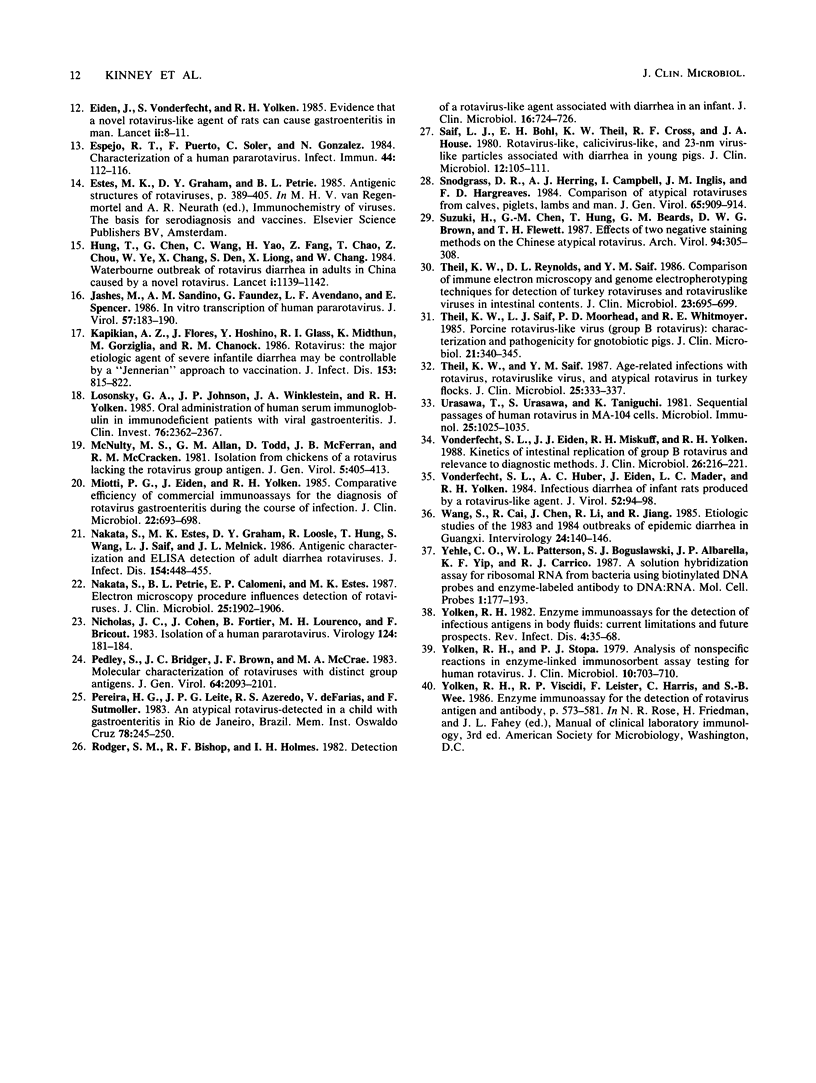
Images in this article
Selected References
These references are in PubMed. This may not be the complete list of references from this article.
- Ambinder R. F., Charache P., Staal S., Wright P., Forman M., Hayward S. D., Hayward G. S. The vector homology problem in diagnostic nucleic acid hybridization of clinical specimens. J Clin Microbiol. 1986 Jul;24(1):16–20. doi: 10.1128/jcm.24.1.16-20.1986. [DOI] [PMC free article] [PubMed] [Google Scholar]
- Askaa J., Bloch B. Infection in piglets with a porcine rotavirus-like virus. Experimental inoculation and ultrastructural examination. Arch Virol. 1984;80(4):291–303. doi: 10.1007/BF01311220. [DOI] [PubMed] [Google Scholar]
- Boguslawski S. J., Smith D. E., Michalak M. A., Mickelson K. E., Yehle C. O., Patterson W. L., Carrico R. J. Characterization of monoclonal antibody to DNA.RNA and its application to immunodetection of hybrids. J Immunol Methods. 1986 May 1;89(1):123–130. doi: 10.1016/0022-1759(86)90040-2. [DOI] [PubMed] [Google Scholar]
- Bohl E. H., Saif L. J., Theil K. W., Agnes A. G., Cross R. F. Porcine pararotavirus: detection, differentiation from rotavirus, and pathogenesis in gnotobiotic pigs. J Clin Microbiol. 1982 Feb;15(2):312–319. doi: 10.1128/jcm.15.2.312-319.1982. [DOI] [PMC free article] [PubMed] [Google Scholar]
- Bridger J. C., Clarke I. N., McCrae M. A. Characterization of an antigenically distinct porcine rotavirus. Infect Immun. 1982 Mar;35(3):1058–1062. doi: 10.1128/iai.35.3.1058-1062.1982. [DOI] [PMC free article] [PubMed] [Google Scholar]
- Bridger J. C. Detection by electron microscopy of caliciviruses, astroviruses and rotavirus-like particles in the faeces of piglets with diarrhoea. Vet Rec. 1980 Dec 6;107(23):532–533. [PubMed] [Google Scholar]
- Chasey D., Banks J. The commonest rotaviruses from neonatal lamb diarrhoea in England and Wales have atypical electropherotypes. Vet Rec. 1984 Sep 29;115(13):326–327. doi: 10.1136/vr.115.13.326. [DOI] [PubMed] [Google Scholar]
- Chasey D., Bridger J. C., McCrae M. A. A new type of atypical rotavirus in pigs. Arch Virol. 1986;89(1-4):235–243. doi: 10.1007/BF01309892. [DOI] [PubMed] [Google Scholar]
- Dai G. Z., Sun M. S., Liu S. Q., Ding X. F., Chen Y. D., Wang L. C., Du D. P., Zhao G., Su Y., Li J. First report of an epidemic of diarrhoea in human neonates involving the new rotavirus and biological characteristics of the epidemic virus strain (KMB/R85). J Med Virol. 1987 Aug;22(4):365–373. doi: 10.1002/jmv.1890220409. [DOI] [PubMed] [Google Scholar]
- Dimitrov D. H., Estes M. K., Rangelova S. M., Shindarov L. M., Melnick J. L., Graham D. Y. Detection of antigenically distinct rotaviruses from infants. Infect Immun. 1983 Aug;41(2):523–526. doi: 10.1128/iai.41.2.523-526.1983. [DOI] [PMC free article] [PubMed] [Google Scholar]
- Eiden J., Vonderfecht S., Theil K., Torres-Medina A., Yolken R. H. Genetic and antigenic relatedness of human and animal strains of antigenically distinct rotaviruses. J Infect Dis. 1986 Dec;154(6):972–982. doi: 10.1093/infdis/154.6.972. [DOI] [PubMed] [Google Scholar]
- Eiden J., Vonderfecht S., Yolken R. H. Evidence that a novel rotavirus-like agent of rats can cause gastroenteritis in man. Lancet. 1985 Jul 6;2(8445):8–11. doi: 10.1016/s0140-6736(85)90057-1. [DOI] [PubMed] [Google Scholar]
- Espejo R. T., Puerto F., Soler C., González N. Characterization of a human pararotavirus. Infect Immun. 1984 Apr;44(1):112–116. doi: 10.1128/iai.44.1.112-116.1984. [DOI] [PMC free article] [PubMed] [Google Scholar]
- Hung T., Chen G. M., Wang C. G., Yao H. L., Fang Z. Y., Chao T. X., Chou Z. Y., Ye W., Chang X. J., Den S. S. Waterborne outbreak of rotavirus diarrhoea in adults in China caused by a novel rotavirus. Lancet. 1984 May 26;1(8387):1139–1142. [PubMed] [Google Scholar]
- Jashés M., Sandino A. M., Faúndez G., Avendaño L. F., Spencer E. In vitro transcription of human pararotavirus. J Virol. 1986 Jan;57(1):183–190. doi: 10.1128/jvi.57.1.183-190.1986. [DOI] [PMC free article] [PubMed] [Google Scholar]
- Kapikian A. Z., Flores J., Hoshino Y., Glass R. I., Midthun K., Gorziglia M., Chanock R. M. Rotavirus: the major etiologic agent of severe infantile diarrhea may be controllable by a "Jennerian" approach to vaccination. J Infect Dis. 1986 May;153(5):815–822. doi: 10.1093/infdis/153.5.815. [DOI] [PubMed] [Google Scholar]
- Losonsky G. A., Johnson J. P., Winkelstein J. A., Yolken R. H. Oral administration of human serum immunoglobulin in immunodeficient patients with viral gastroenteritis. A pharmacokinetic and functional analysis. J Clin Invest. 1985 Dec;76(6):2362–2367. doi: 10.1172/JCI112248. [DOI] [PMC free article] [PubMed] [Google Scholar]
- McNulty M. S., Allan G. M., Todd D., McFerran J. B., McCracken R. M. Isolation from chickens of a rotavirus lacking the rotavirus group antigen. J Gen Virol. 1981 Aug;55(Pt 2):405–413. doi: 10.1099/0022-1317-55-2-405. [DOI] [PubMed] [Google Scholar]
- Miotti P. G., Eiden J., Yolken R. H. Comparative efficiency of commercial immunoassays for the diagnosis of rotavirus gastroenteritis during the course of infection. J Clin Microbiol. 1985 Nov;22(5):693–698. doi: 10.1128/jcm.22.5.693-698.1985. [DOI] [PMC free article] [PubMed] [Google Scholar]
- Nakata S., Estes M. K., Graham D. Y., Loosle R., Tao H., Wang S. H., Saif L. J., Melnick J. L. Antigenic characterization and ELISA detection of adult diarrhea rotaviruses. J Infect Dis. 1986 Sep;154(3):448–455. doi: 10.1093/infdis/154.3.448. [DOI] [PubMed] [Google Scholar]
- Nakata S., Petrie B. L., Calomeni E. P., Estes M. K. Electron microscopy procedure influences detection of rotaviruses. J Clin Microbiol. 1987 Oct;25(10):1902–1906. doi: 10.1128/jcm.25.10.1902-1906.1987. [DOI] [PMC free article] [PubMed] [Google Scholar]
- Nicolas J. C., Cohen J., Fortier B., Lourenco M. H., Bricout F. Isolation of a human pararotavirus. Virology. 1983 Jan 15;124(1):181–184. doi: 10.1016/0042-6822(83)90302-1. [DOI] [PubMed] [Google Scholar]
- Pedley S., Bridger J. C., Brown J. F., McCrae M. A. Molecular characterization of rotaviruses with distinct group antigens. J Gen Virol. 1983 Oct;64(Pt 10):2093–2101. doi: 10.1099/0022-1317-64-10-2093. [DOI] [PubMed] [Google Scholar]
- Pereira H. G., Leite J. P., Azeredo R. S., de Farias V., Sutmoller F. An atypical rotavirus detected in a child with gastroenteritis in Rio de Janeiro, Brazil. Mem Inst Oswaldo Cruz. 1983 Jul-Sep;78(3):245–250. doi: 10.1590/s0074-02761983000300002. [DOI] [PubMed] [Google Scholar]
- Rodger S. M., Bishop R. F., Holmes I. H. Detection of a rotavirus-like agent associated with diarrhea in an infant. J Clin Microbiol. 1982 Oct;16(4):724–726. doi: 10.1128/jcm.16.4.724-726.1982. [DOI] [PMC free article] [PubMed] [Google Scholar]
- Saif L. J., Bohl E. H., Theil K. W., Cross R. F., House J. A. Rotavirus-like, calicivirus-like, and 23-nm virus-like particles associated with diarrhea in young pigs. J Clin Microbiol. 1980 Jul;12(1):105–111. doi: 10.1128/jcm.12.1.105-111.1980. [DOI] [PMC free article] [PubMed] [Google Scholar]
- Snodgrass D. R., Herring A. J., Campbell I., Inglis J. M., Hargreaves F. D. Comparison of atypical rotaviruses from calves, piglets, lambs and man. J Gen Virol. 1984 May;65(Pt 5):909–914. doi: 10.1099/0022-1317-65-5-909. [DOI] [PubMed] [Google Scholar]
- Suzuki H., Chen G. M., Hung T., Beards G. M., Brown D. W., Flewett T. H. Effects of two negative staining methods on the Chinese atypical rotavirus. Arch Virol. 1987;94(3-4):305–308. doi: 10.1007/BF01310723. [DOI] [PubMed] [Google Scholar]
- Theil K. W., Reynolds D. L., Saif Y. M. Comparison of immune electron microscopy and genome electropherotyping techniques for detection of turkey rotaviruses and rotaviruslike viruses in intestinal contents. J Clin Microbiol. 1986 Apr;23(4):695–699. doi: 10.1128/jcm.23.4.695-699.1986. [DOI] [PMC free article] [PubMed] [Google Scholar]
- Theil K. W., Saif L. J., Moorhead P. D., Whitmoyer R. E. Porcine rotavirus-like virus (group B rotavirus): characterization and pathogenicity for gnotobiotic pigs. J Clin Microbiol. 1985 Mar;21(3):340–345. doi: 10.1128/jcm.21.3.340-345.1985. [DOI] [PMC free article] [PubMed] [Google Scholar]
- Theil K. W., Saif Y. M. Age-related infections with rotavirus, rotaviruslike virus, and atypical rotavirus in turkey flocks. J Clin Microbiol. 1987 Feb;25(2):333–337. doi: 10.1128/jcm.25.2.333-337.1987. [DOI] [PMC free article] [PubMed] [Google Scholar]
- Urasawa T., Urasawa S., Taniguchi K. Sequential passages of human rotavirus in MA-104 cells. Microbiol Immunol. 1981;25(10):1025–1035. doi: 10.1111/j.1348-0421.1981.tb00109.x. [DOI] [PubMed] [Google Scholar]
- Vonderfecht S. L., Eiden J. J., Miskuff R. L., Yolken R. H. Kinetics of intestinal replication of group B rotavirus and relevance to diagnostic methods. J Clin Microbiol. 1988 Feb;26(2):216–221. doi: 10.1128/jcm.26.2.216-221.1988. [DOI] [PMC free article] [PubMed] [Google Scholar]
- Vonderfecht S. L., Huber A. C., Eiden J., Mader L. C., Yolken R. H. Infectious diarrhea of infant rats produced by a rotavirus-like agent. J Virol. 1984 Oct;52(1):94–98. doi: 10.1128/jvi.52.1.94-98.1984. [DOI] [PMC free article] [PubMed] [Google Scholar]
- Wang S. S., Cai R. F., Chen J., Li R. J., Jiang R. S. Etiologic studies of the 1983 and 1984 outbreaks of epidemic diarrhea in Guangxi. Intervirology. 1985;24(3):140–146. doi: 10.1159/000149633. [DOI] [PubMed] [Google Scholar]
- Yehle C. O., Patterson W. L., Boguslawski S. J., Albarella J. P., Yip K. F., Carrico R. J. A solution hybridization assay for ribosomal RNA from bacteria using biotinylated DNA probes and enzyme-labeled antibody to DNA:RNA. Mol Cell Probes. 1987 Jun;1(2):177–193. doi: 10.1016/0890-8508(87)90026-0. [DOI] [PubMed] [Google Scholar]
- Yolken R. H. Enzyme immunoassays for the detection of infectious antigens in body fluids: current limitations and future prospects. Rev Infect Dis. 1982 Jan-Feb;4(1):35–68. doi: 10.1093/clinids/4.1.35. [DOI] [PubMed] [Google Scholar]
- Yolken R. H., Stopa P. J. Analysis of nonspecific reactions in enzyme-linked immunosorbent assay testing for human rotavirus. J Clin Microbiol. 1979 Nov;10(5):703–707. doi: 10.1128/jcm.10.5.703-707.1979. [DOI] [PMC free article] [PubMed] [Google Scholar]



